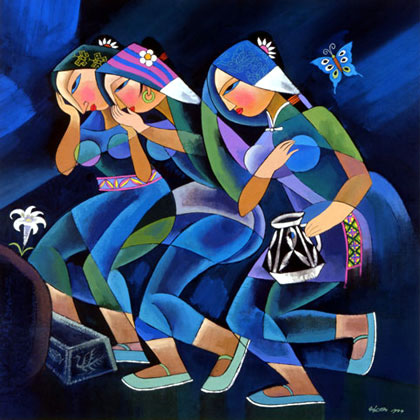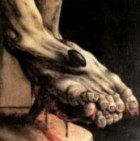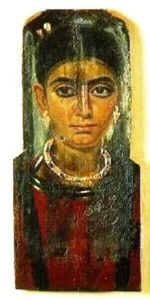Mary Magdalene’s world
Jewish culture under threat
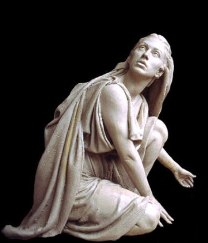
Mary Magdalene on the morning of the Resurrection
Gospel stories are often talked about as if they happened in an imaginary place outside the real world. But in fact they occurred in a particular time and place quite different to our own.
Take the case of Alexander the Great (356-323 BC). Strange as it may seem, Alexander the Great influenced the world in which Mary Magdalene lived. He was not just a military conqueror, but a visionary who wanted to spread Greek culture throughout the world.
There was much that was refined and intelligent in Hellenistic (that is, Greek) culture, and many Jews were tempted to adopt it. But as they did, they found that their own culture and identity were threatened.
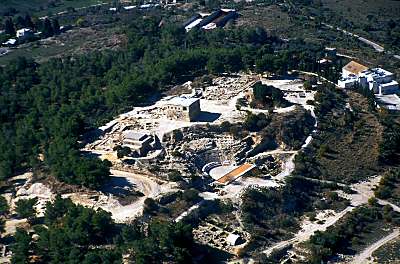
View of present-day Sepphoris from the air
For example, Nazareth where Jesus grew up was a conservative town that clung to traditional Jewish culture. Jesus was brought up with those values.
But only a few miles away was the town of Sepphoris which Jesus must have visited as a boy. Sepphoris showed strong Greek influence, with a Graeco-Roman theatre capable of seating 5000 people.
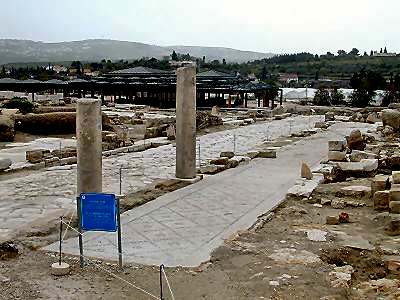
Excavated street pavement and columns in the ancient city of Sepphoris. Jesus almost certainly walked these streets
Economic downturn in Palestine
During Jesus’ life, and especially in the later years, most of Palestine was undergoing a serious economic recession. Despite the fertility of the land, there was unemployment and poverty throughout the country.
The great building programs of Herod the Great had come to an end at about the same time Jesus was born – and don’t forget, Joseph was a builder/carpenter who would certainly have felt the effects of this.
This threw thousands of tradesmen out of work. Without a modern social security system to fall back on, the families of these unemployed men were in a serious situation.
The gospels take place against a background of social dislocation and political unrest.
Jesus’ arrest, trial and execution took place in a climate of political instability and economic uncertainty.
Attitudes to Women
And what about women?
Greek philosophy was greatly admired at the time of Jesus. It changed the way people saw their world.
For example? One of the greatest philosophers, Plato, proposed the theory of dualism, suggesting that everything in the cosmos had an equal and opposite other.
Not relevant to ordinary women? Wrong. Plato’s theory had a profound impact on the way that women were viewed, and it was not to women’s advantage.
‘Woman’ was placed in a negative category:
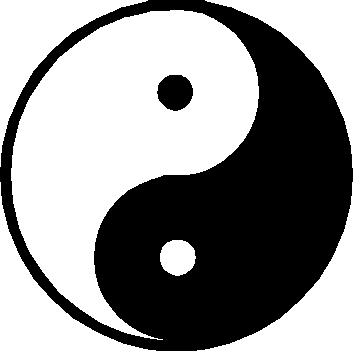
Yin-yang symbol
- Man – Woman
- Civilization – Nature
- Reason/logic – Emotion
- Good – Evil
- Light – Darkness
Keep in mind that
- Civilization was the ideal at the time; Nature was mistrusted and potentially dangerous
- Logic and reason were admired, and emotion was to be subordinated.
- Goodness was always preferable to evil.
- Light, especially in the pre-industrial world, was preferred to darkness.
These are examples only, but they show that Platonic dualism down-graded women.
What effect did this have for women?
- Women were seen as closer to the natural/animal world than men.
- By nature they were irrational and untrustworthy, and therefore unfit to make their own decisions and govern their own lives.
- They had to be looked after and controlled, never treated as equals.
This differed from the traditional Jewish way of looking at the world, which saw all things in creation as integrated and complementary, rather than as opposites of each other.
Here’s an example of a Bible idea that was under attack: think of the creation story of Eve, which says that the first woman was created from a rib taken by God from Adam’s side. If that was so, it suggests that a man could never be fully complete unless he was in partnership with a woman.
Platonic dualism disputed this harmonious balance of the sexes, and put man as ruler.
What about Jewish/Christian Women?

Read the story of Dorcas. You’ll see the story is more about Peter than Dorcas, and shows her in a suitably domestic setting
Jewish and Jewish/Christian women resisted the ideas of Platonic dualism, which patronized them and diminished their status. And while Christianity stayed a Jewish sect, the status of women within the Christian communities was high.
Women in the early Christian communities
But as the ideas of Christianity moved out into the Gentile, Hellenised world, the first Christians found they had to use the Greek philosophical framework to explain their beliefs and be accepted.
So Jesus’ original ideal of mutual respect between the sexes was watered down and changed. Women found they were given roles that were acceptable in the outside, Hellenistic culture.
In doing so, the Christian church stepped back from the radical ideals of the first Jewish/Christians.
Women were still powerful in the private sphere, but were shunted to the side in the public arena. This shows up, for example, in 1st and 2nd century re-tellings of the biblical stories. Where these stories had often had women as central characters, they now focused on men and male activities.
How do we know?
An example of this is the story of Moses’ birth in Josephus’ Antiquities (Josephus was a Jewish writer and historian of the 1st century BC).
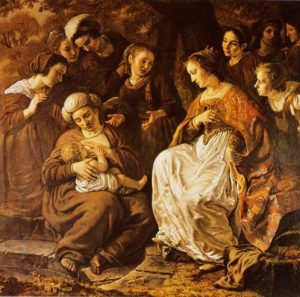
Finding Moses, Jan Victors
In the original biblical telling of the story (in Exodus 1 and 2) the baby Moses is saved by the two midwives, by his mother, by his sister, and by Pharaoh’s daughter – all, obviously, women. This is the version you’ll be familiar with.
In Josephus’ retelling of the story written in about 94AD, the focus is largely on Moses’ father Amram. He performs many of the actions previously attributed to the women. Female characters in the story are changed. The mid-wives in Josephus’ retelling
- are Egyptian, not Hebrew
- are unnamed
- are not present at Moses’ birth
- kill Hebrew babies, not save them.
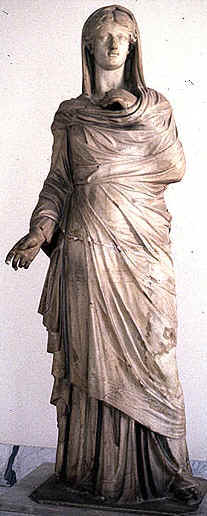
An ideal Roman matron
The basic story of Moses’ birth remains the same, but the female dimension has been attacked and lost.
Why did this happen?
There were reasons for the changes Josephus made to the story. He was trying to counter the anti-Semitism that existed in Rome at the time, so he wrote about Jewish women who behaved like decent Roman matrons! This ideal of Roman womanhood was vigorously promoted in a ‘back to basics’ program by the emperor Augustus and the Roman authorities.
The ideal Roman woman, they said, was
- a mother of many children
- content with her household duties
- kept to her traditional role, in the home
- did not speak assertively to the men in her family
- did not enter the public world.
This model of women was gradually taken over by the early Christians.
For additional information on the lives of women in the Bible, see
Family, Work and Religion: the tribe, the family, slaves, women’s tasks, beliefs
Milestones in a woman’s life: Puberty, menstruation, marriage, childbirth, death, burials
Search Box
![]()
For example, make a list of movies about women like Mary, who take a leadership role to support someone they believe in…
Da Vinci Code:
true? false?
Interview with
Elizabeth Fletcher
© Copyright 2006
Elizabeth Fletcher



